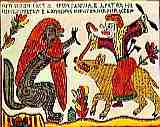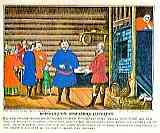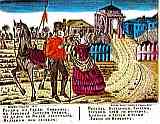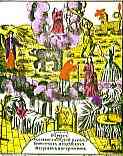LUBOK ENGRAVERS AND PRINTERS.
LUBOK CENTERS.
KIEV
Pamva Berynda (1550/60-1632)
A scholar, engraver, and typographer, Berynda is best known for his publication of the Lexicon of Slavonic-Russian Words and Explanation of Names, a 7000-word dictionary and interpretation of words and proper names derived from the Greek, Latin, and Hebrew. In 1628-29, he printed his Calendar (today in Bodleian Library, Oxford), with 12 pictures, one for every month of the year. Each page includes all the Orthodox saints celebrated in a particular month, which is an approach similar to the so-called monthly icons. The Calendar has a strong anti-Catholic and anti-Uniate bias. Berynda may also be the author of The God-Pleasing Dungeon (1629).
Ilia the Monk
One of the most prolific engravers employed by the Kiev-Pechersky Monastery, author of about five hundred prints. In 1645-49, he cut 132 out of the planned 150 illustrations to the Bible, using as examples the pictures from the Dutch edition of the Piscator Bible, but adapting them skillfully to the Russian tastes and including details from Russian life. Between 1655 and 1660, Ilia produced forty eight prints for the Kiev-Pechersky Paterikon. His engravings are remarkable for their depiction of the caves, the architecture, and everyday life of the monastery.
Vasilii Koren'
 Perhaps the most famous of the early Russian print artists, between 1692 and 1696 Koren produced 36 pictures for the Bible and the Apocalypse, inspired by Dürer's works, but also adapted for the Russian readers; his Biblical characters often wear contemporary Russian clothes. Koren's prints display excellent technique characterized by uncluttered, monumental compositions and bold outlines. On the basis of the similarity in lettering and using short, non-crossing parallel lines to indicate drapery folds, shadows, and animal fur, scholars hypothetically attribute to Koren', an opponent of Petrine reforms, such prints as Yaga-Baba Rides to Fight the Crocodile, The Cat of Kazan, and How the Mice Buried the Cat (Ovsiannikov 12).
Perhaps the most famous of the early Russian print artists, between 1692 and 1696 Koren produced 36 pictures for the Bible and the Apocalypse, inspired by Dürer's works, but also adapted for the Russian readers; his Biblical characters often wear contemporary Russian clothes. Koren's prints display excellent technique characterized by uncluttered, monumental compositions and bold outlines. On the basis of the similarity in lettering and using short, non-crossing parallel lines to indicate drapery folds, shadows, and animal fur, scholars hypothetically attribute to Koren', an opponent of Petrine reforms, such prints as Yaga-Baba Rides to Fight the Crocodile, The Cat of Kazan, and How the Mice Buried the Cat (Ovsiannikov 12).
MOSCOW
Ilia Yakovlevich Akhmet'ev
Akhmet'ev started in 1744, in his own home, printing on two presses images of Christ, the Virgin, and saints. During his career spanning more than fifty years, he operated one of the first printing "factories," a typography with 20 presses,which employed the best engravers of the time. Akhmet'ev's typography is responsible for disseminating pictures of "registers of beauty marks" and "registers of colors," as well as thirty illustrations to Alexander Sumarokov's verses.
Vasilii Onufrievich Kipriianov
In 1705, Kipriianov and his son opened a print shop not far from the Savior Gate of the Moscow Kremlin. Four years later, they began the publication of the first Russian calendar, named Bruce's Calendar because of collaboration of the Count Jacob Vilimovich Bruce, one of Peter the Great's favorites, an astronomer and mathematician. The calendar was printed yearly for six years in sheets of large format; then it was resized and, as the Small Bruce's Calendar, continued to appear till 1742. Forty seven printed pages of the calendar included maps, information about the liturgical year and about the Eastern Orthodox Church, astrological divinations, explanations of lunar eclipses, distances between various Russian and foreign cities, and agricultural advice.
I. A. Morozov (and his sons)
 Began publishing around 1850s. Born in a poor peasant family in Tver province, Morozov worked in Moscow as a street picture peddler. He started to make his own prints and when the printing turned out to be a success, Morozov made it his principal business. His activities expanded during the Crimean War and he became a merchant. The sons of Morozov were not as devoted to the business as their father. Between 1850 and 1875, the Morozov print shop published, among many others, The Return of the Man from Yaroslavl, Alexander of Macedon, and A Funny Little Folly.
Began publishing around 1850s. Born in a poor peasant family in Tver province, Morozov worked in Moscow as a street picture peddler. He started to make his own prints and when the printing turned out to be a success, Morozov made it his principal business. His activities expanded during the Crimean War and he became a merchant. The sons of Morozov were not as devoted to the business as their father. Between 1850 and 1875, the Morozov print shop published, among many others, The Return of the Man from Yaroslavl, Alexander of Macedon, and A Funny Little Folly.
Andrei Abramov
 A successful printer, called Zhulik (swindler, cheat) by his contemporaries because he was reputedly the stingiest of the cheap publishers. In the late nineteenth century his trade turnover reached two hundred thousand rubles. Between 1870 and 1885, Abramov's printing shop produced such prints as Ilia Muromets, Ivan Tsarevich, What a Noise They Are Making Outside, Hussar, Upon His Sabre Leaning, The Assumption, and others.
A successful printer, called Zhulik (swindler, cheat) by his contemporaries because he was reputedly the stingiest of the cheap publishers. In the late nineteenth century his trade turnover reached two hundred thousand rubles. Between 1870 and 1885, Abramov's printing shop produced such prints as Ilia Muromets, Ivan Tsarevich, What a Noise They Are Making Outside, Hussar, Upon His Sabre Leaning, The Assumption, and others.
Ivan Aleksandrovich Golyshev (1838-1896)
 A peasant scholar and typographer. Studied art at the Stroganov Drawing School in Moscow. In 1858 opened in Mstera (Vladimir province) the first village press to publish lubok pictures. From the middle of the 1870s, the estate where Golyshev built a house in which he lived and worked, was known as Golyshevka. Its five hand-operated presses printed three thousand pictures daily. Golyshev employed two hundred village women to color the prints. The typography closed in the middle of the 1880s, not being able to compete with Moscow chromolithography. Golyshev studio produced, among others, the pictures of The Birds of Paradise, Pantiushka and Sidorka, The Soldier's Farewell, Come and Get Vladimir Cranberries, Do not Curse Me, My Dear, In the Evening a Fair Maiden, The Ploughman's Song, as well as the covers for The Fortune Telling Book and The Dream Book.
A peasant scholar and typographer. Studied art at the Stroganov Drawing School in Moscow. In 1858 opened in Mstera (Vladimir province) the first village press to publish lubok pictures. From the middle of the 1870s, the estate where Golyshev built a house in which he lived and worked, was known as Golyshevka. Its five hand-operated presses printed three thousand pictures daily. Golyshev employed two hundred village women to color the prints. The typography closed in the middle of the 1880s, not being able to compete with Moscow chromolithography. Golyshev studio produced, among others, the pictures of The Birds of Paradise, Pantiushka and Sidorka, The Soldier's Farewell, Come and Get Vladimir Cranberries, Do not Curse Me, My Dear, In the Evening a Fair Maiden, The Ploughman's Song, as well as the covers for The Fortune Telling Book and The Dream Book.
CENTERS OF HAND-DRAWN LUBOK:
Vyg-Leksa
The earliest and strongest center of hand-drawn lubok formed around the male Old Believer monastery on the river Vyg and the female monastery on the river Leksa, founded at the end of the seventeenth century. The center was most productive between 1790 and 1830, and lasted till 1857, when the monasteries were closed. The pictures are characterized by large cinnabar initials, the headings written in decorative viaz' (link) lettering, color combinations of raspberry red, green, and gold, vases with fanciful flowers, trees with apple-like fruit painted in two colors, birds flying over the trees and carrying in their beaks branches with tiny berries, the clouds resembling rosettes with three petals, and anthropomorphic representations of the sun and the moon.
Ust'-Tsilma
Founded around the Velikopozhensky Monastery on the lower Pechora river and opened in 1715, the center is best known for the monumental portraits of the cenobiarchs of the Old Believer communities. The portraits, executed in slightly subdued colors, lack the decorative qualities of the other centers but are expressive and monumental. The majority of surviving prints can be dated between the second quarter of the nineteenth century and the beginning of the twentieth, despite the closing of the monastery in 1854.
Northern Dvina
The center began issuing pictures about 1820 and continued till the beginning of the twentieth century. A characteristic motif is a flowering branch with large, tulip-like flowers. Predominant color of the pictures is red and the artists often use the uncolored background. The style of the Northern Dvina pictures is rooted in the regional tradition of manuscript illustration and in folk painting on wood.
Vologda
The center was active at the end of the nineteenth and the beginning of the twentieth century. The pictures have a well-developed narrative character, The artists preferred to illustrate parables, legends and tales from the Great Mirror, stories from the Synaxarion and Paterikon. The pictures tend to concentrate on the information contained in the text, on its narrative element, not on its beauty. Multifigured compositions are common. Preferred colors of the Vologda artists are yellows, browns, and dark orange. Sometimes the words spoken by the characters are shown written on long strips attached to their mouths (like in comic books).
Guslitsy
Even though the earliest preserved work of the center dates back to 1828, most drawings were made between the middle and the end of the nineteenth century. The style of Guslitsy pictures is linked with the illustrated manuscript tradition. The lettering is proportional, elegant, and slightly elongated. The initials, large and richly ornamental, stand out as if they were the most important part of the picture. Colors are more saturated and brighter than in the Vyg-Leksa lubki.
Moscow
No specific common stylistic features can be established for the Moscow center because it included many individual artists. Even though they were acquainted with the traditions of hand-drawn lubok in the North, they tried to add something of their own. Sometimes they liked to produce more than one picture to illustrate a tale particularly full of interesting details (The Story of Esther).
Copyright Alexander Boguslawski 1999HOME
 Perhaps the most famous of the early Russian print artists, between 1692 and 1696 Koren produced 36 pictures for the Bible and the Apocalypse, inspired by Dürer's works, but also adapted for the Russian readers; his Biblical characters often wear contemporary Russian clothes. Koren's prints display excellent technique characterized by uncluttered, monumental compositions and bold outlines. On the basis of the similarity in lettering and using short, non-crossing parallel lines to indicate drapery folds, shadows, and animal fur, scholars hypothetically attribute to Koren', an opponent of Petrine reforms, such prints as Yaga-Baba Rides to Fight the Crocodile, The Cat of Kazan, and How the Mice Buried the Cat (Ovsiannikov 12).
Perhaps the most famous of the early Russian print artists, between 1692 and 1696 Koren produced 36 pictures for the Bible and the Apocalypse, inspired by Dürer's works, but also adapted for the Russian readers; his Biblical characters often wear contemporary Russian clothes. Koren's prints display excellent technique characterized by uncluttered, monumental compositions and bold outlines. On the basis of the similarity in lettering and using short, non-crossing parallel lines to indicate drapery folds, shadows, and animal fur, scholars hypothetically attribute to Koren', an opponent of Petrine reforms, such prints as Yaga-Baba Rides to Fight the Crocodile, The Cat of Kazan, and How the Mice Buried the Cat (Ovsiannikov 12).

